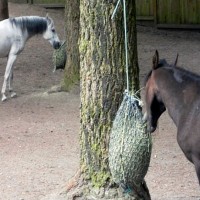
When I started making NETgrazers three years ago, many options for feeding my horses became available to me. I had access to the strongest netting available from my commercial fishing partners, a variety of mesh sizes and an unlimited supply of recycled nets. I also found a source for locally grown round baled hay. I fed my horses timothy grass hay grown in the dryer climate of Eastern Washington, but with the rising price and shortage of hay I decided to experiment with round baled hay.
I set out to understand horses foraging needs. My goal was simple: keep them happy and healthy. Not only was I concerned about my horses, but with my new business, I would be supplying other horse owners and care givers with feeding options for their horses. I needed facts to back up my NETgrazer guarantee.
The science of equine nutrition is constantly evolving. I read everything I could get my hands on. I consulted experts in horse health care: veterinarians, farmers, hay brokers and horse owners. I untangled the facts from the opinions and came up with a simple code to follow for buying and feeding hay that would stand the test of time.
Horse Feeding Code:
- Horses are designed to consume small amounts of hay continuously to effectively maintain proper gut function and to ward off behavioral vices caused by boredom.
- Horse hay should be soft and leafy with a clean aroma and free of foreign objects.
- Match the nutrient content of the hay to the needs of your horse.
- While we can’t put a price on our horses’ health, hay prices have been rising and we must manage the costs to care for them over the long term.
So, how does feeding round-baled hay match up to this simple code? The short answer: It works for some horses and horse owners, for others it does not. Before you go to the trouble of bringing round bales into your paddock there are a few things to consider. I fed round-baled hay to my horses for two years. Here’s what I learned and how it mapped to the feeding code.
Horses are designed to consume small amounts of hay continuously to effectively maintain proper gut function and ward off behavioral vices caused by boredom.
- One 400lb round bale in a NETgrazer with 2” mesh size on pallet under shelter lasted two horses two weeks grazing 24/7.
- No hay wasted!
- No mold.
- Happy, healthy horses!
Horse hay should be soft and leafy with a clean aroma and free of foreign objects.
- All bales inspected daily. No foreign objects found.
- Soft leafy, long stem grass hay.
- Outside layer of the round bale was lightly bleached, but still soft. Inside layers had some greenish hue mixed with light beige color.
- All layers smelled clean and fresh.
- All bales stored on pallets under tarps
Match the nutrient content of the hay to the needs of your horse.
- Round bales purchased locally consisted of mixed hay: timothy, bermudagrass, orchardgrass and some fescue.
- Horses lived in paddock with occasional light trail riding
- Horses browsed and grazed, nibbled and moved.
- No supplements fed to horses
- Happy, healthy horses!
While we can’t put a price on our horses’ health, hay prices have been rising and we must manage the costs to care for them over the long term.
- Monthly cost to feed two horses:
- (2) Round bales, delivered: $140.00
- Round bale NETgrazer*: $ 7.00
- Pallet: $ 0.00
- Total monthly cost/two horses: $ 147.00
*Medium size Roundbale NETgrazer: $80.00, depreciated over 1 year.
Finding the right hay for your horses is a journey. At times it is frustrating. There are so many opinions and misconceptions. I cannot monitor the nutrient content of every bale I buy so the horse feeding code works for me. The round baled hay was an excellent way to feed my two trail horses. I spent far less time feeding and way more time riding. They were healthy and happy. Now, I take care of 4 rescued horses. Their nutritional needs are different. They each get carefully measured grain and supplements. In order to pass the feeding code test, I buy timothy grass hay from one broker who consistently delivers the same high quality. Although I cannot feed round baled hay to these horses, we do enjoy the benefits of feeding with NETgrazers. I fill 4-6 NETgrazers with 1-2 flakes each and hang them around the paddock. The horses can browse and graze, eating grass hay that meets their nutritional needs. I hang nets twice a day and they spend about six hours a day doing what horses love: graze!
There are many realities in a horse’s life today, but none should preclude access to hay and ample time to “nibble and move.”